Superfoods for Babies and Recipe Ideas
This post may contain affiliate links. As an Amazon Associate, I earn from qualifying purchases. Please read my disclosure.If you’re looking for superfoods for babies, this post will provide you a list of the baby superfoods you will want to have on hand so that you can fill your babies small tummy with nutrient rich foods! Plus find some simple to make recipes using these ingredients!

Babies don’t eat that much in a given day because their tummies are so small. Which is why it’s important to make sure that the foods they do eat are packed with nutrients. But honestly, these 10 foods could be considered “the top 10 superfoods for anyone” – not just for babies!
So what is a “superfood”?
Superfoods are whole foods that are nutrient powerhouses, pack large doses of antioxidants and polyphenols, are easily digestible, and full of fiber and a complex blend of vitamins and minerals. After looking at this list, I came up with a “menu” for babies that incorporates pretty much every single one of these food items into her diet each day!
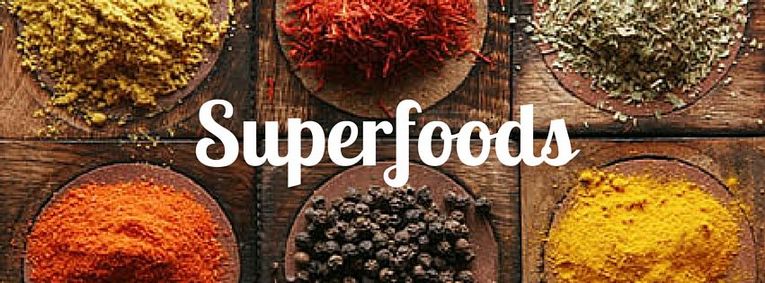
What are the most nutritious foods for babies?
Blueberries
What are the health benefits of blueberries for babies?
These little gems are bursting with antioxidants and flavonoids, which benefit your baby’s eyes, brain, and even urinary tract.
They are high in fiber, vitamin C, vitamin K, and manganese. They have the most antioxidants of all the fruits. They can help with brain function and memory, which is excellent for baby!
Blend or mash them into my blueberry puree recipe, which you can mix with yogurt or oatmeal for a healthy breakfast.
Organic Whole Milk Plain Yogurt For Babies
How does organic whole milk plain yogurt benefit my baby?
This creamy delight is rich in calcium, vitamin D, and gut-soothing live cultures (probiotics). Be sure to buy the whole milk variety – your baby needs the extra fat and calories. And don’t get any fruit-flavored versions – they have way too much sugar. Stick to plain, organic, whole milk and mix in your own fruit purees as needed.
Remember that whole milk plain yogurt should be given to babies at least 6 months or older. It does not replace formula or breast milk at this stage.
Prunes
How are prunes healthy for babies?
These dried plums have TONS of fiber and antioxidants, and are great to add into your baby’s diet especially when they’re first switching over to solids. Prunes also offer protein, vitamin B6 (which helps to process protein), potassium which helps to balance fluids, and vitamin K which helps with healthy blood. If your baby is constipated, prunes are a natural laxative that can help to relieve pain.
Try this apple & prune puree to keep your little one regular.
Prunes can be high in sugar, so it’s best to mix them with other purees.
Avocado
Why are avocados good for babies?
The perfect first food for your baby, avocados are rich in healthy fats that help boost brain development. Avocados have a wide assortment of vitamins and minerals including vitamins C, E, and K, B vitamins, magnesium, zinc, and manganese. They are also a great source of fiber. While they don’t contain much protein, the healthy poly and mono-unsaturated fats provide your baby with needed calories in a healthy plant-based form.
Preparing an avocado puree for your baby is just about the easiest puree you can make. All you need is a ripe avocado and a fork! Both my children loved avocado when they were babies, and had no problem gobbling it up!
Broccoli
How does broccoli benefit my baby?
This cruciferous veggie contains fiber, folate, calcium, and tons of antioxidants. In addition, broccoli contains vitamins A, C, K, B6 and folate, and minerals including iron and zinc. Iron and zinc are essential for your babies growth and development.
Get your baby used to this (and other green veggies early), and you’re sure to train their tastebuds to enjoy healthy food!
I mix broccoli, cauliflower and spinach together to get a superfood veggie blend. Then I’ll often mix that into my lentil stew for a hearty dinner for my kids when they were babies.
Lentils
What are the health benefits of lentils for babies?
All legumes have a healthy combination of protein & fiber which is great for your baby. But lentils have the added benefit of becoming mushy when you cook them for long periods of time, which means no pureeing needed! combine lentils with yogurt for a high protein, high fiber nutrient rich lunch or dinner!
You can introduce lentils to your baby around 6 months old. Because babies begin to lose iron around the age of 6 months, introducing lentils that are high in iron at this age is great for your baby!
Kale
How do you add kale to your babies food?
Kale can be a tough green to eat. However, when it’s chopped, cooked, and mixed with other foods, your baby can easily enjoy this powerhouse of a leafy vegetable!
Kale is one of the most nutrient dense foods around! It is packed with vitamins A, C, and K, as well as calcium. The added calcium helps your baby build strong bones.
It’s also a great source of iron, folate, and has all of the antioxidant benefits of the cruciferous veggie family. Kale, swiss chard, and other leafy greens are great to introduce to your baby. Make a leafy green and lentil stew for your baby – you can use any green veggie in the soup and it will taste great.
Cauliflower
How does cauliflower benefit my baby?
Cauliflower is yet another cruciferous veggie with a milder flavor that’s very baby friendly. Make a healthy “mashed potato” for your little one.
Cauliflower is full of vitamin C with helps your baby absorb iron. It’s also an excellent source of vitamin K and B vitamins. It’s rich in antioxidants that support your baby’s organ function and immune system. Not only that, cauliflower is another superfood that helps with constipation.
Sweet Potato
A great first or second food for your baby, sweet potatoes are good source of potassium, vitamin C, fiber and an excellent source of beta-carotene. They are also one of the best sources of vitamin A which helps with your baby’s vision.
You can’t go wrong with this simple sweet potato puree recipe.
Butternut Squash
How does butternut squash help with my baby’s growth and development?
Butternut squash is full of healthy vitamins and minerals that can help your baby’s development in a variety of ways. It is rich in vitamin A for eyesight. High in B vitamins for healthy blood. And it’s packed with vitamin C for healthy skin. In addition, it is rich in vitamin E for brain development.
Butternut squash also contains beta carotene, and this is another super-easy-to-digest first food that babies tend to adore. Caramelize this squash in the oven and then puree, baking it in the oven will add a depth of flavor your baby will adore.
How do you prepare these superfoods for babies throughout the eating stages?
6 to 9 Months:
Cook the food well, and create a puree. You can serve the puree to your baby with a spoon. As they get closer to 9 months, you want to encourage them to self feed. This helps your baby become more independent with their own feeding. It also helps with their motor development. Your baby will also have the opportunity to explore different textures.
9 to 12 Months:
Once your baby has reached 9 months, it’s a good time to introduce bite sized pieces of food that they can feed to themselves. This works great with avocado, sweet potato, butternut squash, and very well cooked broccoli, and cauliflower. Your baby will also be developing their pincer grasp, which allows them to pick these foods up with their thumb and fingers.
You can also provide your baby with a spoon, for their purees, and encourage them to spoon feed themselves. This will get a bit messy, but is important to teach your child how to scoop and bring the spoon to their mouth before the contents fall off.
12-24 Months:
Once your baby has reached 12 months, now is a good time to give them bite sized pieces of soft food, and provide them with a fork to use to pick it up, and bring it to their mouth. Model for your baby how this is done. If your child is not interested right away, that’s okay! They may go between using their fingers, and their utensils. Give them the opportunity to try out using the fork, but don’t over pressure your little one if they go back to their fingers. As they get older continue to offer it, until it becomes natural.
Once your baby is used to purees, you can start giving them chunkier versions of these same foods and start mixing them together with spices.
What superfoods are best for baby brain development?
- Plain Whole Milk Greek Yogurt: As mentioned above, plain whole milk yogurt is a superfood. It is also one of the best foods for your baby’s brain development. The healthy fats help develop brain cells and provide probiotics which help build a strong microbiome.
- Avocado: The healthy poly mono-unsaturated fats in avocados contribute to brain cell development.
- Whole Grain Cereals: When providing your baby with whole grain cereals opt for oats, quinoa, and barley that are ground and blended into a fine powder. Then add to boiling water to create a creamy puree. Feel free to mix with whole milk yogurt, breast milk, or formula. These whole grains offer fiber and protein that helps with your baby’s brain development.
- Apples: This popular fruit contains quercetin which stimulates brain activity!
- Lentils: This high protein legume contains fiber, iron and protein; the combination of which is beneficial for baby’s brain development.
- Leafy Greens: As mentioned above, leafy greens are one of the superfoods for babies. They provide lutein and Vitamin K which helps with brain activity.
Superfoods For Babies: Feeding Schedule
Here is the basic menu I created for my kids starting at 6-7 months old. It makes it easy to incorporate almost every single one of these superfoods into your baby’s diet each day. These baby food recipes are easy to prepare and make it easy to create your own healthy baby food at home.
This menu is perfect for babies aged 6-12 months, but honestly you could follow this for years to come with some modifications (e.g. chunkier foods, more spices added, more variety in cuisines, etc.).
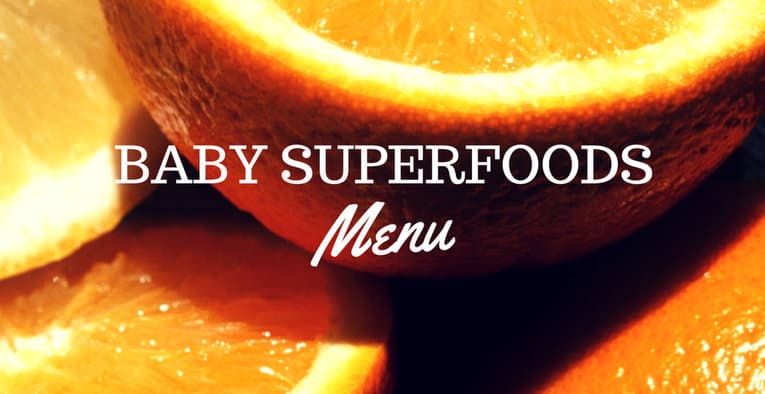
Breakfast: 7-8oz food
2-3oz Blueberry “smoothie” with oatmeal; 2-3oz apple & prune with oatmeal
12:30pm Lunch: 7-8oz food
3oz Broccoli, Spinach, Cauliflower Puree + 2oz Lentil Stew + 2oz Yogurt + 1oz Oatmeal (to thicken if needed)
3:00pm Snack: 2-4oz food
1-2oz Avocado + 1-2oz quinoa or whole wheat pasta
5:30pm Dinner: 7-8oz food
3oz Sweet Potato + 2oz Butternut Squash + 2oz Oatmeal
OR
4oz Leafy Greens + Lentil Soup + 2oz Cauliflower/Potato + 2oz Quinoa or Brown Rice
Baby Superfood Recipes
This “menu” makes it so easy to add superfoods into your babies’ diet, it will seem like no effort at all and will hopefully take some of the stress and pressure off when it comes time to start solid foods. Here are all the recipes you need to start incorporate these superfoods for babies into your child’s daily diet.
Breakfast for Baby
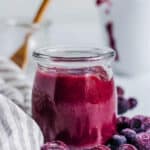
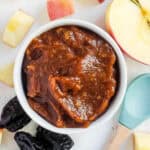
Lunch for Baby
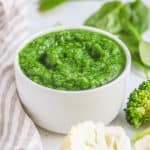
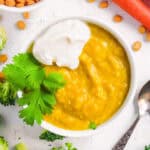
Snack for Baby
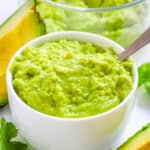
Dinner for Baby
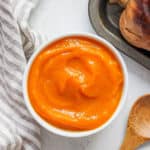
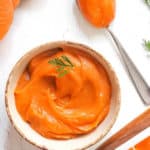
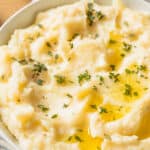

I can’t wait to hear how your little ones like these recipes!



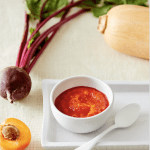




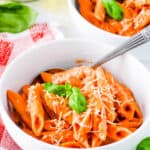


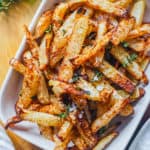

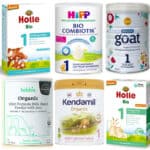
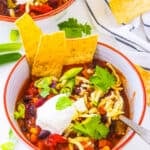


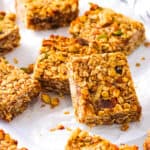



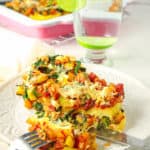
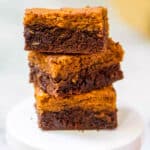
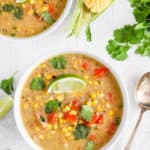

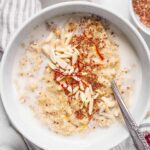
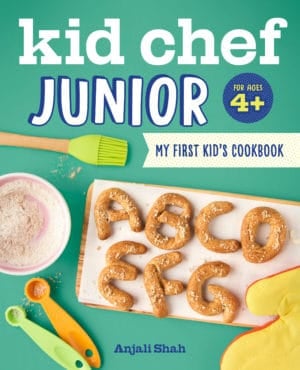



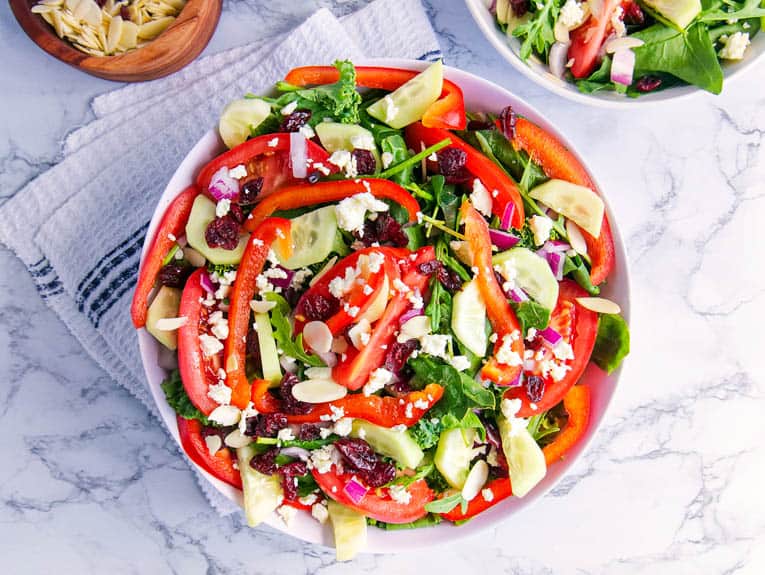


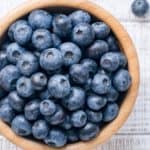
Hi,
Do you have any posts about how to start finger foods/chunkier foods at 9 months? or any meal ideas for that age? Also, when/how did you incorporate peanut butter for the first time?
Thank you!
Hi Jenna! For finger foods at 9 months I recommend starting with Organic O’s that are easy to gum like Cascadian Farms Purely O’s — these are great for practicing the “pincer grasp” and you can give your baby one “O” at a time to avoid risk of choking/etc. For chunkier foods – I just recommend starting with making chunkier purees using the same recipes you are using now. But instead of pureeing completely, either puree it partially, or just mash it up with a potato masher. You can basically increase the “chunkiness” as your baby gets more and more used to chewing/gumming foods. You can use this meal planning guide and just change the texture of each of the recipes to suit your little one! For peanut butter, with my daughter we introduced it at 1 year – since at that time the guidelines were more strict around allergens like nuts. For my son, who was born just 2 years ago, our pediatrician was ok with us introducing a small amount on a daily basis starting at 7 months so we did it then. I would say just ask your pediatrician when they recommend you start with nuts/allergens for your baby based on your baby’s health/family history and go from there!
Hi Anjali,
Love your blog so much. On the oatmeal for baby, does it work with the rolled oats that adults eat, those that I normally soak in hot water for 10 min and then consume directly. Can I use the same for baby 7 months old? Take the rolled oat that I normally eat, soak in hot water then blend it?
Hi! Yes, absolutely – that would work great! 🙂
Hi Anjali,
Thank for this wonderful recipes. Question on Oatmeal, which oatmeal (brand) do you prefer for babies, mine is 6.5 months old, and how do you make it. I want to introduce oatmeal to her and not sure where to start.
Hi Poonam! I actually just prefer to get regular rolled oats and grind them into a flour-like consistency in the food processor, and then I just cook them the way I would regular rolled oats (with water, in the microwave or on the stove top). It works great!
Hello! I am new to your blog and love it! I have read several articles urging not to feed babies cereals because their body is not yet able to properly digest grains( body does not make the necessary enzymes yet). What are your thoughts on this? Also, what type of cereal do you use?
Hi Olivia! Thanks so much!! I’m so glad you like my blog and it’s great to “meet” you! To your question about cereals – I agree to hold off on cereals, but for a different reason! First, I never recommend introducing rice cereal (ever – unless your pediatrician recommends it due to an allergy concern) – it’s not nutritious at all and is usually super refined. And in general, I don’t like introducing cereals as a first food – or even as an early food – because babies palates are already used to sweet/bland tastes and textures and cereal is just an extension of that. I recommend starting with mild veggies like sweet potatoes, carrots, green beans, peas, avocado (which is technically a fruit 🙂 ) etc. Then moving on to fruits and lentils/beans, and then introducing grains along with the lentils/beans. And when you do introduce cereal, I recommend starting with oatmeal and quinoa which you can actually make yourself by grinding the whole grains down to a powder and then cooking the same way you would regular oatmeal or quinoa! Hope that helps, let me know if you have any other questions!
Hi anJali, I will like to start solids soon with my little one. I have a questions regarding the portion , I know you said to store in a ice cube rack, so should she be having a ice cube for each serving to start or less
Hi Francheska! So yes! Each ice cube counts as 1 ounce of food. So to start, you can do 1 ounce 2 times a day (depending on how excited about food your little one is, you can do more or less in each sitting). As your daughter gets more used to food, you can increase portions to as much as she wants to eat! Eventually – this guide will be helpful for you in knowing how many oz to give in each feeding and what times (approximately) work for meals. My son at 12 months was doing 3 meals a day with 6-7 ounces of food in each meal. But to start, 1oz, once or twice a day is good! (so that would be 1-2 ice cubes total per day). Hope that helps, let me know if you have any other questions!
Loved your posts on the baby food recipes.Good work!Our pediatriacian has recommended high calorie diet and weight gaining food for our 9 month old baby girl.It will be great if you please can share some suggestions.
Thanks in advance!
Hi Mandy! Is your baby girl not gaining enough weight? If so, I’d recommend incorporating a lot of healthy fats into her diet – e.g. whole milk yogurt with her meals, organic butter, coconut oil, extra virgin olive oil, or ghee mixed into her food, full fat cheese, avocado daily, and nut butters mixed into her food (as long as she isn’t allergic). If you add some of those healthy fats into each of her meals that should help her gain weight! Let me know if that makes sense and if you have any other questions!
Thanks for your quick response Anjali.
Yes I have already started adding coconut oil and olive oil to her food.Can I also add the oil to her oatmeal with formula.
I have few questions if you please can guide:
1.Can I also add the oil to her oatmeal with formula?
2.She is 9.5 months and currently drinks only around 15 oz of formula.Is it ok.I keep on offering her through out the day but she rejects most of the time.
3.She drinks Similac Isomil.I saw your post on formula.Is there any good soya choice for those European formula which you’ve recommended.
4.Can we start giving her cheese or nut butter at 9.5 months?
5.Can we give her organic jaggery and wheat germ?
By the way, congratulations for your new book ???? I am waiting to grab a copy tomorrow ????.
Hi Mandy! No problem at all! To your questions:
1) Yes, you can add a bit of oil to her oatmeal with formula as well!
2) If she’s eating 3 full meals per day, 15oz formula may not be too little. It really depends on how much food she’s consuming. Most babies will drink at least 24oz formula at 9 months of age, but it depends on how much food she’s eating. I’d also rely on what your pediatrician says since he or she has been able to see and interact with your baby which is important for determining how much your baby should be eating and drinking!
3) Is your baby allergic to lactose? Is that why you are using a soy formula? If so, Baby’s Only with Soy is a good option. Otherwise, if you don’t need a soy formula but need to avoid cow’s milk, I’d recommend Kabrita which is a goat milk formula. Or if you need a hypoallergenic formula I’d recommend HiPP HA.
4) Yes you can do cheese and nut butter at 9.5 months! I’d just recommend giving it in the morning so you can monitor for an allergic reaction throughout the day.
5) I wouldn’t recommend giving her organic jaggery at all since it is basically just a form of sugar. I’d avoid all added sugars for the first two years of life. Wheat germ is perfectly fine as long as it’s ground up enough for her to be able to swallow!
Thank you so much (regarding the book!) I can’t wait for you to get a copy – please let me know how your little one likes the recipes once you do!!
Hi Anjali! I have a question. At what time should I breastfeed my baby considering the above listed time schedule? Thank you
Hi Ami! You can nurse your baby in between meals – so for example: you can nurse when your baby wakes up for the day, and do breakfast around 9 or 10am, have lunch, and then nurse around 3pm (instead of a snack), and then do dinner and nurse before bedtime. Let me know if that makes sense and if you have any questions!
Hey, great recipes! I’m a little apprehensive about giving packed superfoods available on the shelves of supermarket. Should I give them to my 10 month old baby? We just found out that his growth is not up to the chart but he is quite active and healthy.
Thanks Vaishali! By “packed superfoods” do you mean the pre-packaged toddler fruit/veggie purees? The ones that you can squeeze out of the packaging? If so, those are perfectly safe to give to your baby, but in my opinion, they are expensive and it’s much cheaper to make your own baby food at home. Also – most of those purees don’t have the right proportion of fruits to veggies (they usually overdo it on fruits so that the mixture is sweet, and it ends up having mostly fruit and less veggies than it should). So I’d recommend just making fruit and veggie purees at home! If your baby is 10 months he should definitely be eating solid foods 3 times a day along with breastmilk or formula. As far as his growth goes – without knowing more details I can’t provide too much help, but as long as your pediatrician says you are feeding him enough and they aren’t concerned I wouldn’t worry too much about it! If you do want him to get more calories, healthy fats like avocado, whole milk yogurt, olive oil, coconut oil, nut butters (if he’s not allergic) are great to add into his daily meals. Hope that helps!
These are all awesome, and so great you posted these.. I make kitchari all the time for my kids- with my 9 mo old we are following baby lead weaning, So i actually make your version more grainy with 1 cup lentils: 1 cup rice and 2 cups water, mixed with frozen veggies and pinch of some spices. He loves to pick up each grain and feed himself. I was just curious if your recommended quantities of foods per meal were based on anything specific, and at what age should they be eating these quantities? I’ve noticed that my LO really won’t nurse ( he refuses bottles) if he eats too much food so its tough to find a balance when he just feeds him self chunkier foods vs purees. I do purees more on the go, and just give him what we’d eat or big brother eats at the table if there is time, but I feel like it’s not more than an oz or two of actual food (not pureed) per meal and if I give more than that he doesn’t feed too well… maybe the water content is much higher in the puree its equivalent? .. i know its always recommended that the baby’s milk is more important than solids before age 1 so i try to nurse before giving solids, but he seems to love solids so much 🙂 Anyways just wondering if these recommendations were really for older babies, or just based on what your daughter is taking at the moment 🙂 This is a fantastic article… we use almost all these foods on a daily basis, so good to know you are too!
Thanks Nina!! Oh that’s so cool that you’ve been doing baby led weaning – I wasn’t courageous enough to try that with Layla initially (was too worried about choking) – so we’re doing chunkier foods now instead 🙂 Regarding quantities of food — honestly that’s just what Layla is eating these days and it’s loosely based on the “how much should your baby eat” guides on BabyCenter, Parents Magazine, etc. But every baby is different and some babies may eat more than others at each sitting – if your LO is growing, healthy, and your pediatrician says all is well, I wouldn’t worry about him only eating 1-2oz of food at each meal. Layla ends up eating the same amount whether it’s a puree or chunky food (when we’re giving her chunky food she also drinks water from her sippy cup, so it probably ends up being equivalent to the puree – which is a little more watery like you said). Layla’s 12 months, but has been doing this amount of food since about 7-8 months – with some fluctuations here and there. Regarding when to nurse vs. giving solids – do you space the two out? We don’t feed Layla unless it has been 2 or more hours from her last “meal” – whether that was milk or solids – so that helps her to eat more in each sitting. Here is her current feeding schedule in case it helps: https://74.220.215.66/~pickyeat/a-sample-feeding-schedule-for-your-baby-6-12-months/. Let me know if you have any other questions!!
Wonderful ideas! My daughter is 8 months old and so far likes everything she has tasted except banana babyfood–she likes plain fresh banana, but in the jar it has added citric acid, which gives it a tangy flavor that just tastes wrong, I agree! We are going to continue feeding her a wide range of foods in hopes that she continues to be willing to eat most things, like her brother who is now 10 years old. He got more particular when he was around 3, but he’s always eaten more variety than a lot of American kids. Masoor Dal is one of his very favorite foods; we make it somewhat spicy and mix in grated carrots, and the baby loves it, too.
Thank you so much Becca! I agree with you about the pre-made baby food – they have to add citric acid to help preserve it, but it does change the taste of what the fruit or veggie actually tastes like in nature! Sounds like you’ve been doing great with both of your kids – love that they both love Masoor Dal with veggies! That’s one of Layla’s favorites too 🙂